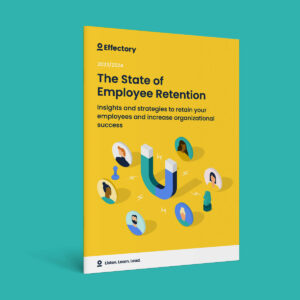You’ve hired the perfect candidate. Now it’s time to think about retention: lengthening the time that talent stays in your organization. Thanks to the costs associated with high turnover and the ongoing war on talent, retention is a big business topic, and HR is crucial to business meeting this challenge.
What is employee retention? Everything you need to know

What retention means
Retention can be looked at in different ways. From working out what it is as a number that can be tracked to understanding what improves retention, thinking about what keeps employees engaged and satisfied with their work is an important task.
It can be measured and shown as a statistic. Here’s the formula for working out employee retention in your business:

The number for the “total # of employees” should be from the start of the period that is being measured, and the “total # of employees that left” should be based on the same period. It is good practice to measure retention across regular intervals, every quarter or year, for example, so that data is comparable over time.
The State of Employee Retention
Uncover why employees leave, hidden costs to organizations, and proven retention strategies in our insightful report.
DownloadBy regularly tracking the level of retention at regular intervals, businesses can build up a reservoir of data which allows them to track their retention rates over time.
For example:
- In 2022, you track retention rates in Q1, Q2, Q3 and Q4, using fresh data sets each time, and relevant only for those time periods.
- At the end of the year, you can see how your retention rate fluctuated across the year. Why is that?
- You repeat the same process in 2023 and 2024. Now you can compare quarterly retention rates across three years.
- Perhaps you’ll spot patterns. Do more employees leave during certain parts of the year? Have periods of high turnover coincided with changes to business operations?
- Now you can analyze why things have happened the way they have, and make plans to mitigate risks to retention moving forwards.
This is where the meaning of retention gets more complex. Figuring out a number is one thing, but knowing what those numbers represent and how they can be influenced is a different matter.
Why should you care about retention?
The retention rate tells us how long talent wants to stay at an organization. But why is this important?
Because high turnover makes two big impacts:
- The financial cost
- The loss of expertise
Let’s start with the financial costs. According to Gallup, U.S. businesses spend more than $1 trillion a year replacing employees who voluntarily decide to leave their jobs.
In Germany, turnover has been increasing in recent years. Here, the difference between engaged and disengaged employees is clear. While 82% of engaged employees state that they plan to remain with their current organization for at least another year, only 41% of actively disengaged employees say this same. And 19% of disengaged employees are actively looking for a new job.
Given that the costs of replacing an employee ranges from up to 90% of a yearly salary for an entry-level position, to 200% for professionals and leaders, these potential turnover numbers should be raising alarm bells for anyone in human resources and leadership.
Then there’s the loss of expertise. This is especially true when mid- and long-term employees exit the building. They take their personal relationships with colleagues, as well as their productivity levels and their experience, with them whenever they leave.
Mid- and long-term employees are also much more likely to have better relationships with customers. And customers like continuity, because it gives them a sense that their long term goals and concerns are understood and being taken into consideration.
Download the Employee Experience Review
Discover how employees around the world are experiencing different parts of the employee journey and how this affects the employee experience.
DownloadWhat’s behind employee turnover?
There are many reasons people leave their job. Some of them are out of the control of an employer. Perhaps it’s time for a sabbatical, or a change of career, or a return to full time education.
There are other reasons for someone leaving an organization, however, which can be mitigated by management and HR. Here’s some of them:
- Lack of development potential. In the mid-term, employees can start to feel stuck. Having mastered their core function, eager talent wants to expand their role. Perhaps by taking on more responsibility, being more involved in organizational matters, or diversifying their working day with new tasks. But this is only really possible if they are given the time and resources to learn at work and be shown the route by which they can progress up the company hierarchy.
- Working environment and philosophy no longer suits them. This has been a big theme during the pandemic. Peoples’ attitude to hybrid work and remote working have been brought into focus. Looking to retain younger staff? Maybe they’re less keen to commute every day. Are long serving employees finding the new work/life balance hard to manage? Maybe they’re not being given all the support they need.
- Being offered a great (financial) rewards elsewhere. Financial reasons are a common cause for employees accepting a new position at a different company. Is your organization matching the competition’s renumeration? Factors such as paid holiday leave and additional time off around Christmas or other traditional holidays may also play a role when employees are thinking about their next career move.
Employee experience in 3 easy steps
Learn the best ways to improve the employee experience in your organization with these 3 easy-to-follow tips! Get your copy today!
Download: employee experience tipsWhat can be done to boost employee retention?
Like for every part of the employee journey, expanding the time for which talent is engaged with their work can be done with an HR and management approach that treats employees’ concerns seriously. Why not read our article ‘Engagement and retention are related – here’s how‘ to find out more about how working to increase engagement can lead to increased retention rates.
During the hiring process, a business may already offer various benefits designed to sweeten the deal. This could include voluntary days, bonuses based on results, or stock options.
But on a rolling basis, it’s much more likely that it’s smaller, operational issues that are going to get under an employee’s skin. According to research by Effectory, engagement can be positively influenced by themes such as:
- Management allowing staff the space to work autonomously
- Employees having sufficient training
- There being a high level of role clarity
As we can see, it’s not only for financial reasons that people may seek to exit a company.
But whether it’s for financial reasons or something operational, the only way HR and management will ever really know what is on their employees’ minds is by asking them. It used to be that companies would run one big survey a year, but it’s becoming increasingly more common to roll out a continuous listening strategy, where shorter and more focused question sets are asked more regularly.
This approach keeps management’s and HR’s fingers on the pulse, and flags up issues that may lead to people looking for opportunities elsewhere.
To find out more about how retention can be boosted with a engagement-oriented listening strategy, read out our article ‘How to use employee listening to boost retention‘.
Employee retention summary
Retention is the degree to which your talent stays at an organization. It can be measured and results can be compared over time, providing an insight into the trends that define and effect retention in an organization.
Retention is important to consider because employee turnover is expensive and results in expertise and good relationships with customers disappearing.
While various factors, such as a lack of ability to progress professionally, may encourage people to find new work elsewhere, organizations can proactively promote retention through boosting employment with the help of a continuous employee listening strategy.
Book a free demo. See our solutions in action.
Effectory is Europe’s Leading provider of Employee Listening Solutions. Schedule a product demo and discover how to enhance your employees’ engagement.
Demo request


